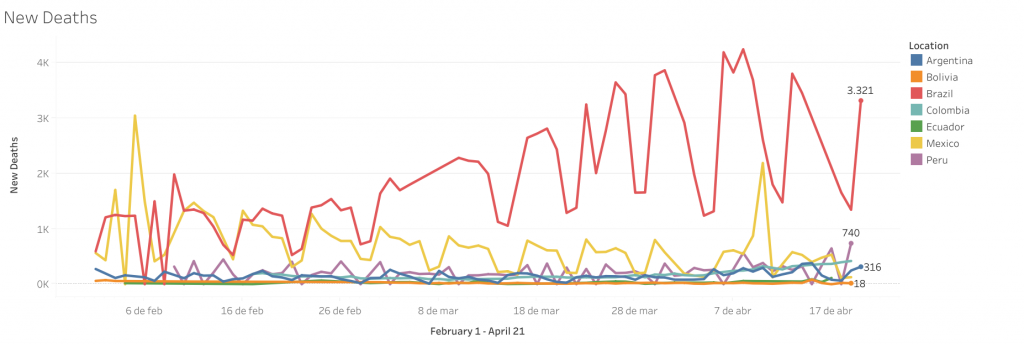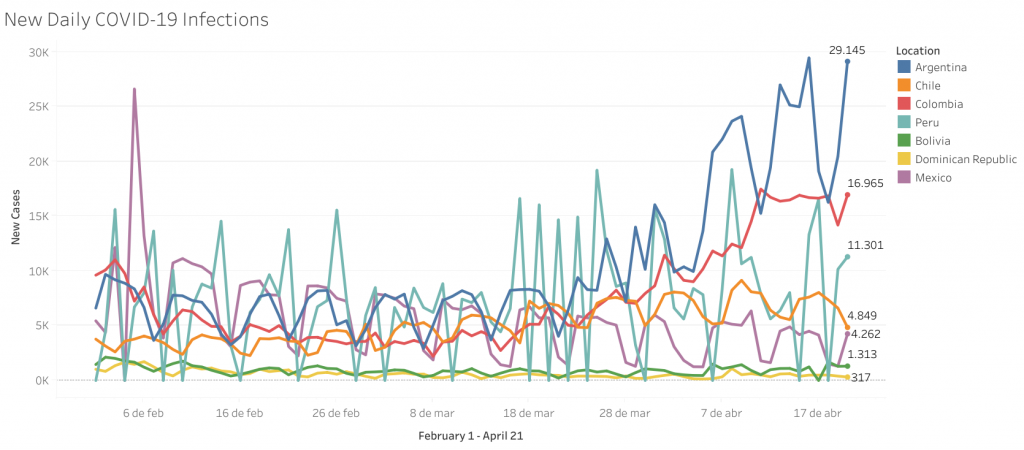What You Should Know
- New Report: Written in collaboration with the Inter-American Development Bank, LAC 2025: Three Post COVID Scenarios,is our take on the region’s post-COVID future, including the pandemic’s lasting impact and opportunities for a sustainable and resilient recovery.
- International Earth Day: Latin America and the Caribbean’s first environmental treaty officially went into effect on Thursday, April 22. The Escazú Agreement is the first treaty of its kind to include the protection of human rights defenders in environmental matters.
- La Soufrière: The UN is launching a $29 million funding appeal to help people in St Vincent and the Grenadines and other countries affected by the eruptions of the La Soufrière volcano. The eruptions caused the displacement of nearly 20,000 people.
- 176: Brazil reported 176 deaths per 100 thousand inhabitants, surpassing the mortality rates of every other country in the Americas, including that of the United States. Here are this week’s figures.
Health + Innovation
- Argentina: Argentine lab Richmond manufactured and sent a batch of 21,000 doses of the Sputnik V vaccine to Moscow to obtain approval. If greenlighted, the lab will start mass production of the vaccine in June in its Buenos Aires plant. This would be the first sight of regional production of the Russian vaccine.
- Brazil: The country is closing a deal to purchase another 100 million doses of the Pfizer vaccine. Brazil’s first delivery of a promised 100 million doses from Pfizer is expected to arrive next week.
- Third Dose: Pfizer’s CEO, Albert Bourla, says people might need a booster dose of the company’s vaccine within 12 months after their second dose.
- Mexico: On April 20, President Andrés Manuel López Obrador received the AstraZeneca COVID-19 vaccine, urging people that the benefits outweigh the risks of the vaccine.
- Panama: An additional 2 million doses of the Pfizer vaccine will be purchased, bringing the total to 7 million doses. Yet, to date, the country has received only 600,000 doses of the vaccine.
Economies in Focus
Multilateral Analysis
- The IDB reports that the region suffered the worst economic decline in 200 years as a result of the pandemic. Thirty-nine million Latin Americans have lost their jobs and another 44 million have fallen into poverty.
- IMF Western Hemisphere Department Director Alejandro Werner cautioned that regional GDP per capita would not reach pre-pandemic levels until 2024.
Economic Aid
- Uruguayan authorities increased financial support for the sectors most affected by the pandemic by $360 million, bringing the total designated this year to offset the pandemic’s impact to $900 million.
- Panama’s private sector presented the government with a reactivation plan that proposed $4 billion in investment to generate 208,000 direct and indirect jobs.
- The Colombian government will issue global bonds due in 2032 and 2042 to meet the country’s budgetary needs.
Quarantines + Travel Restrictions
Quarantines + reopenings
- Uruguay extended containment measures including school closures, the closure of duty-free shops, gyms, and night clubs, and limits on operating hour limits until April 30. The measures were first announced on March 23.
- Colombian authorities will maintain restrictions in cities with high ICU occupancy until May 3. As Bogotá’s ICU occupancy continues to rise, the city has been placed under a nightly curfew beginning at 8:00 p.m.
- On April 16, Argentina announced new restrictions for Buenos Aires including a nightly curfew from 8:00 p.m. until 6:00 am for non-essential workers. In-person classes were also suspended. The measures will remain in effect until April 30.
- Costa Rica reimposed restrictions on movement, limiting which cars are allowed on the streets based on the last digit of the license place during the weekends.
- Paraguay further extended restrictions until April 26 on operating hours, capacities, and alcohol sales. The measures were first enacted on April 9.
- Ecuador will impose a strict stay-at-home order beginning Fridays at 8:00 p.m. until Mondays at 5:00 a.m. and a nightly curfew during the week beginning at 8:00 p.m. until May 20.
- On April 19, Peru imposed mandatory stay-at-home orders on Sundays, and other restrictions for provinces deemed high-risk, among other restrictions. The measures will remain in place until May 9.
- Beginning April 19, Panama allowed bars with open-air patios to resume service and relaxed the nightly curfew as cases declined.
- The Brazilian state of São Paulo reopened churches and malls despite an increase in cases, although the nightly 8:00 p.m. curfew will remain in place; gyms, hair salons, and restaurants will remain closed until at least April 24.
Border and travel restrictions
- Panama will require all travelers coming from South America to undergo and pay for a molecular COVID-19 test upon arrival. Travelers must also isolate for 3 days regardless of test results.
- Mexico will extend border restrictions prohibiting non-essential land border crossings until May 21 in all southern states and northern states classified as orange (high-risk) and red (extreme) risk per the country’s four-light system governing the country’s reopening plans.
- France announced new health and safety requirements for travelers coming from Argentina, Brazil, and Chile. Travelers must present a negative PCR test taken no more than 36 hours before their flight and complete a 10-day quarantine upon arrival. France is only allowing French and European Union members to enter the country.
In Focus: South America Remains in Troubled Waters
- The slow delivery of vaccines, distribution hurdles, relaxation of health measures, and the circulation of more contagious strains of the virus are leading to a surge in COVID-19 cases and deaths in South America.
- In Brazil, less than 9 million of the country’s 210 million residents have been vaccinated. The country reported a global one-day record of 4,000 COVID-19 related deaths last week.
- In Chile,despite widespread vaccination (almost 40 percent of the total population has received at least one dose), COVID-19 cases and deaths continue to soar. Experts say the surge has been partly driven by more contagious strains of the virus and the relaxation of health measures.
- After recording the highest number of COVID-19 deaths since the pandemic outbreak, regional authorities in Colombia are now reporting difficulties implementing the national vaccination plan, due to delays in the delivery of vaccines by pharmaceutical companies and domestic distribution challenges.
By the numbers
- Vaccinations per capita (vaccines administered per 100 people): Chile (71) #4 worldwide, Uruguay (42) #16 worldwide, Antigua and Barbuda (30) #18 worldwide, Dominica (26) #35 worldwide, Barbados (25) #40 worldwide, Saint Kitts and Nevis (20) #51 worldwide, Brazil (16) #55 worldwide, Dominican Republic (14) #58 worldwide, Costa Rica (14) #60 worldwide, Panama (14) #62 worldwide), Source: nytimes.com
- Deaths per capita (deaths per million people): Brazil (1,771) #14 worldwide, Peru (1,738) #16 worldwide, Mexico (1,639) #20 worldwide, Panama (1,417) #25 worldwide, Colombia (1,348) #30 worldwide, Chile (1,317) #32 worldwide, Argentina (1,313) #33 worldwide, Bolivia (1,076) #38 worldwide, Ecuador (997) #40 worldwide, Aruba (877) #49 worldwide, Source: worldometers.info
Quick take


